CBI World Ag Expo is pleased to announce during the 2019 World Ag Fest we will be an Authorized Sponsor recognizing our New Saddle Cap!
Website SEO by Pakus Web Services by Pakus Trading Company, LLC.
Website SEO by Pakus Web Services by Pakus Trading Company, LLC.
CBI Pipe and Rodeo go together like butter and bread; and with warm weather comes all of the fun outdoor activities to enjoy, including a family favorite, rodeos. CBI Pipe & Supply shares their Top 5 rodeo selections nationwide, each of them a must-visit if you are in the area.
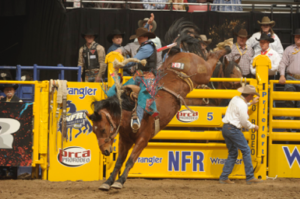
Where: Davie, FL
When: Rodeos take place throughout the year
What makes it great: If you are looking to catch a rodeo in the middle of winter, then Davie Pro rodeo is up your alley. Due to Florida’s cooperative climate, rodeo fans have been able to catch a high end rodeo in February if they so choose, since 1986.
For more information or tickets, visit http://davieprorodeo.com.
Photo Courtesy South Florida Finds
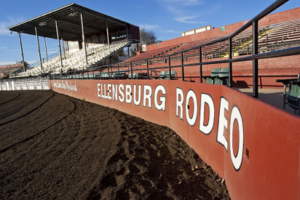
Where: Ellensburg, WA
When: August 30th – September 3rd
What makes it great: What an awesome way to celebrate Labor Day! The Ellensburg Rodeo features country music entertainment and a carnival, as part of the Kittias County Fair. It also invites visitors to experience the Yakama Nations Indian Village and Western Village. It is the last stop on the PRCA Extreme Bulls Tour as well!
Learn more about this rodeo the full schedule of events at http://ellensburgrodeo.com.
Photo courtesy Ellensburg Daily Record
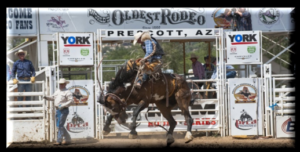
Where: Prescott, AZ
When: June 28th – July 4th
What makes it great: Staking claim as the birthplace of the modern day American rodeo, Prescott Frontier Days knows how to put on a show. Celebrating 131 years and counting, this rodeo will feature eight rodeos and its 129th Fourth of July Celebration.
Visit their website for more event info, tickets, and a world class photo gallery. www.worldsoldestrodeo.com.
Photo courtesy Prescott Frontier Days, Inc.
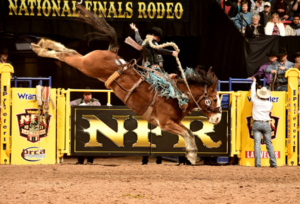
Where: Las Vegas, NV
When: December 6th – 15th
What makes it great:Need an excuse to go to Vegas, baby? This is it! A culminating event of the year’s rodeo competitions, the National Finals Rodeo has been called the Super Bowl of rodeos. It even hosts the annual Cowboy Christmas, a huge cowboy swag convention. The countdown is on to this year’s event.
See the lineup of events at http://nfrexperience.com.
Photo courtesy Las Vegas Review-Journal

Where: Cheyenne, WY
When: July 20th – 29th
What makes it great: What doesn’t make this rodeo great? Since 1897, Cheyenne Frontier Days has worked to build its reputation as the premier rodeo in the country. This year’s event is sure to please with a carnival for the kids, nightly performances by Eric Church, Charlie Daniels Band, Toby Keith, and even an air show. Make a vacation of it and enjoy a non-stop fun-filled week in picturesque Cheyenne Wyoming.
You’ve got to check it all out on their website, http://www.cfdrodeo.com.
Make sure ro contact us for any rodeo fencing needs!
Photo courtesy Cheyenne Frontier Days
Website SEO by Pakus Web Services by Pakus Trading Company, LLC.
Livestock App – These days, there is literally an app for everything. Everything – including apps to help livestock and cattlemen manage all aspects of their herd. And guess what, there are a ton to choose from. We’ve done some researching and have found 5 stand-out herd management apps that may help your farm run even smoother.
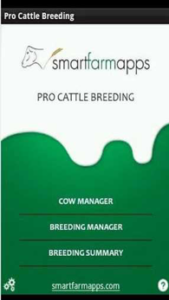
Use this app to help you track all things leading up to and during breeding including:
• Pre-mating heat
• First heat
• Artificial insemination date
• Pregnancy scan date
• Positive or negative pregnancy results
• Due date
Capture breeding data and graph it for every cow in your herd, and keep track of which bull bred with which cow.
The best part? You can use this app offline, when internet isn’t readily available.
Photo courtesy farms.com
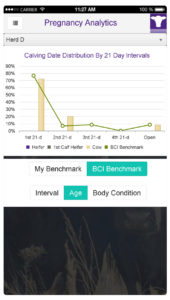
Along the same vein as the Pro Catle breeding app, BCI Pregnancy Analytics allows producers to collect cattle pregnancy data and compare with industry benchmarks, promoting more efficient breeding.
Trackable cattle data includes:
• Pasture/herd name
• ID
• Age
• Body condition
• Number of days bred
Photo courtesy iTunes
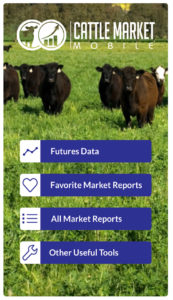
Keep in the know on the most current auction prices with this app. For feeders as well as cow/calf producers, this app helps producers determine the right time to sell their calves, and helps feeders determine the right time to buy calves.
Current states listed in this app include:: Alabama, Florida, Georgia, Illinois, Iowa, Kansas, Kentucky, Missouri, Nebraska, North Carolina, North Dakota, Oklahoma, South Carolina, South Dakota, Tennessee, Texas, Virginia, Washington, West Virginia and Wyoming.
The reputable data is provided by USDA’s Agricultural Marketing Service.
Image courtesy of iTunes.
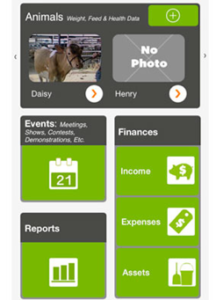
This app is literally a virtual record book in the palm of your hand. With this app you can capture and track weights, purchases, health records and events attended. You can then choose to export the data and for quick and easy record book completion.
Image courtesy of University of Nebraska

Not just for cattle, this app tracks up to 90 fields of information for pigs, goats, horses, chickens, and other livestock.
Some relevant fields include:
• Animal ID
• Family lineage
• Gender
• Birth date
• Birth weight
• Weaning date
• Photo
• GPS Info
• Pasture Management
• Breeding info
• Health records
Image courtesy of iTunes
This information intensive app is designed to better manage feed, labor, and other needed supports to more efficiently maintain your livestock. Data will sync to iCloud so that current information is available to all of your staff on their devices.
Some of these apps have a fee attached. Some are free. But if you are a pro-tech rancher searching for a better way to manage your herd, all of these have benefits that may take you to the next level of efficiency. Make sure to check out CBI Pipe’s livestock fencing products! Contact us with any questions.
Website SEO by Pakus Web Services by Pakus Trading Company, LLC.
A Wire Grip Cable Puller is a tool that allows a user to latch on to a wire or cable to assist in creating tension on a wire rope. Tightening wire rope is used in many applications, including the implementation of wire rope or cable fencing. Use of wire grip cable puller allows for any slack to be removed quickly and easily, and creates a more structurally sound build than manually tightening.
While fast and easy are always desirable, a key reason for using wire grip cable puller is also safety. Using an alternate tool to tighten your wire rope creates a likelihood that the cable could slip or snap. Our wire grip cable puller features a flat metal lock to keep the wire in the grip.
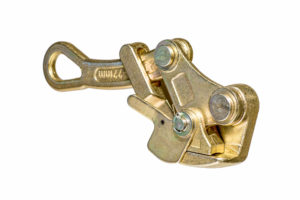
In this video, we are using a 1-Ton (#1) Cable Grip attached to a 3-Ton 1/4″ Galvanized Come-Along or Cable Puller (aka Cable Puller). We are inserting 3/8″ used shot line cable inside the cable slot of the Cable Grip and then sliding the safety down to secure the cable in the grip. At that point we crank the come-along to take up the slack and pull tension onto the cable until it’s the desired stiffness. On the other end of the cable, we have looped cable around a post and used a 3/8″ Malleable Cable Clamp to secure the cable together to anchor to the post. Everything used in the video is sold by CBI Pipe & Supply.
In addition to the materials seen in the video, CBI Pipe & Supply sells various sizes and weights of both wire grip and wire rope. We have years of experience using these products in the field and can help you select the products, and provide you the advice to get the job done right.
Got a project that calls for wire rope? Contact CBI Pipe today and get the best possible solution for your needs.
Website SEO by Pakus Web Services by Pakus Trading Company, LLC.
Pipe Saddle Caps – If you have ever been involved in a pipe fence installation, you know what a saddle cut is.
If you have never been involved in a pipe fence installation, let us explain what a saddle cut is.
A saddle cut is a specific cut needed to get one pipe to wrap around the curve of another pipe (as seen in below image)
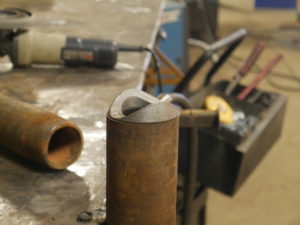
This specific cut has always been essential to well-crafted pipe fencing…and it is historically time consuming.
But in 2016, CBI Pipe changed the game when they introduced saddle caps to the industry. It’s so new and so exclusive to CBI Pipe that there isn’t much wide-spread information about them out there. Go ahead, try to Google it.
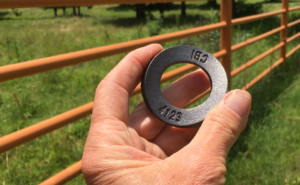
Saddle caps are pre-fabricated, weld-able rings with wings that fit over the end of pipe and connect to another curved piece of pipe. For those of you that have ever been involved in a pipe fence installation, you may already see the time saving value of this product. Just imagine – no more cutting torch.
CBI customers who are leaders in pipe fence installation are already heavily using them to save time and increase their bottom line. To date, they have already sold over 200,000 saddle caps of all sizes! Hoffman Brothers Welding and Fabrication offers a video of these being installed in the field here. (link to video)
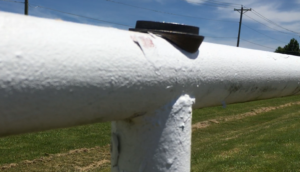 Working through the newness of the product, CBI Pipe is continually making the saddle cap product better for their customers. The product was originally made of weld-able steel cast iron. CBI evolved the product by putting a hole in the middle, making the wings smaller and changed the manufacturing process from casting to forging. These enhancements decreased the weight by 60%, drastically cutting on shipping costs and keeping overall cost down for customers. They are now offered in several different sizes to fit your project.
Working through the newness of the product, CBI Pipe is continually making the saddle cap product better for their customers. The product was originally made of weld-able steel cast iron. CBI evolved the product by putting a hole in the middle, making the wings smaller and changed the manufacturing process from casting to forging. These enhancements decreased the weight by 60%, drastically cutting on shipping costs and keeping overall cost down for customers. They are now offered in several different sizes to fit your project.
These revolutionary pieces are in high-demand, and CBI Pipe is diligently working to increase their availability nation-wide. If you are interested in getting some shipped for your fencing project, or have more questions, contact CBI Pipe today, or visit their website: cbipipe.com
Website SEO by Pakus Web Services by Pakus Trading Company, LLC.
Customer Spotlight Series – Even though winter doesn’t seem to want to let go, spring is most definitely here, and farmers are pushing into full throttle. This ramping-up brings on needs for new fencing, new feeders, and equipment repair and fabrication. Enter Hoffman Brothers. Located in Hoyt, Kansas, this family-owned company is quickly establishing a reputation as the local experts in all things welding and fabrication. Hoffman Brothers Welding and Fabrication prides themselves on the flawless execution of anything from custom livestock feeders to endless lengths of pipe fencing.
CBI Pipe and Hoffman Brothers have forged a successful relationship to better serve their customers. Recently, we sat down with Hoffman Brothers to learn a little more about them and what makes their company such a success, in a game we like to call the “Quick Six.”
Hoffman Brothers Customer Spotlight Series Quick Six
Customers of Hoffman Brothers trust in their hard-working, back to basics philosophy. They know that they can call on Hoffman Brothers to assist them with a repair out in the field or a one-of-a-kind fabrication job. CBI Pipe is proud to call them a trusted business partner.
To learn more about Hoffman Brothers Welding and Fabrication, visit their site, hoffmanbrotherswelding.com, or give them a call 785-986-6310.
If you have any questions or inquiries for CBI, please feel free to contact us!
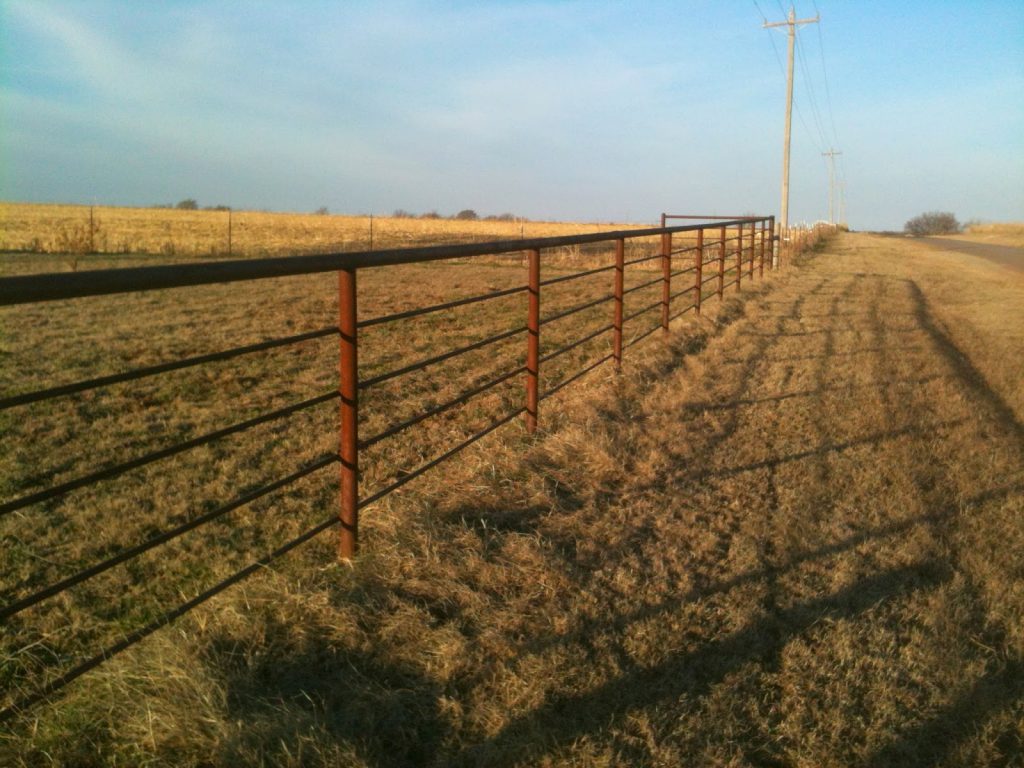
Website SEO by Pakus Web Services by Pakus Trading Company, LLC.
Bull Buyers Guide – A Guest Blog by Travis Meeter, Extension Educator, Commercial Agriculture
Bull Buyers Guide – Are you sifting through stacks of bull sale catalogs looking for your next bull? While bull selection can be a daunting task, your choice will impact your herd for years to come. Thus, taking some time to think about what you need from your next herd sire is important.
Here are some points to emphasize when it comes to bull selection.
Know your market. Understand what traits are value added-traits for your Bull Buyers Guide market.
While selling calves at weaning into the commodity market is the majority, some cattlemen are marketing in very creative ways. Local freezer beef, retained ownership, alliances, branded beef programs, video sales, or fitting the production environment to a consumer demanded practice. Your bull selection should be based on traits that are profitable in your market.
Don’t sacrifice functional traits or adaptability to your production environment.
It is really easy to get caught up in the data, but remember these critters need to be sound and function in the pasture. Good feet and legs, a strong libido, and docility are all imperative. Masculinity, big testicles, and a tight sheath are good phenotypic indicators of the right kind. Bull buying guide that are raised in similar conditions to your farm is preferred. You can buy someone else’s genetics, but you can’t buy their management.
Require a passed BSE (Breeding Soundness Exam) and farm herd health protocols.
I also suggest a quarantine period for new purchases. A minimum of two weeks will allow time for potential pathogens to break without exposing your herd. Lots of times cattle coming from a sale have experienced elevated stress. It is important to keep them on good feed, in a clean pen, and allow the quarantine period to run its course.
Identify and understand Expected Progeny Differences (EPDs) and phenotypes that signify value added traits you are seeking.
Calving ease (CE) is an important and valuable trait. Sometimes when talking to producers I hear them stressing CE and birth weight (BW). BW is an indicator trait for CE, but you don’t get paid for light birth weight calves. You get paid by not having to invest time and labor in pulling calves. So, avoid putting too much downward pressure on BW, especially if the bull will breed cows. Another mistake I see is purchasing low BW bulls for cows. This is not necessary. Many times you can purchase a bull with average or better calving ease for cows at a discount to “heifer bulls” with comparable growth. Smooth, flat shouldered bulls with decent CE EPDs are good value bulls for breeding mature cows.
If you sell your calves at weaning through the sale barn and keep your own replacements, traits of priority should be CE, heifer pregnancy, stayability, and weaning weight. Selecting for more yearling weight, too much milk or too little milk, or carcass traits are much less important in this scenario. If you retain-ownership in your cattle through the feedlot and market to the packer, then yearling weight and carcass traits become more relevant to your bottom line. Your ultimate goal should be to produce the most profitable product, thus seek traits that add value without increasing cost of production over the value of the trait.
Utilize appropriate multiple trait selection indexes. Find the sweet spot/ profitable window in milk, YW, and carcass EPDs.
Avoid putting too much emphasis on one trait. Nearly all breeds now have dollar index values that help put economics to trait selection. These indexes can be extremely effective tools if the index scenario matches your operation. Weaned Calf Value ($W) is a dollar value used by the Angus breed. It is an index that is designed for cattlemen that primarily sell calves at weaning. This index also assumes that replacement heifers are retained. EPDs for birth weight, weaning weight, milk, and mature cow size are focused on. Lower birth weights, heavier weaning weights, and lower mature cow size are desirable. Bull Buying Guide. Milk production is weighted both positively and negatively as it directly impacts calf weaning weights, but also increases cow maintenance requirements. A more detailed description of economic selection indexes is available on my blog at http://web.extension.illinois.edu/oardc/eb275/entry_7912/
Don’t be fooled by index names.
Beef Value ($B) is a terminal index. It is a great tool for cattlemen that are not keeping replacements. This index will increase profitability of cattle in the feedlot and on the grid. Unfortunately, I have heard $B referred to as a comprehensive EPD index several times, which it is not. It is vital to understand that $B is a terminal index. Don’t be afraid to ask questions. The breeder or an Extension specialist will be able to help explain the numbers.
Demand higher accuracy for traits.
Technologies are available for seedstock producers to increase the accuracy of EPDs on yearling bulls. Genomic-enhanced EPDs result in less risk, less change, and more predictability in how a yearling bull will sire. A bull buyer can feel more confident now than ever in EPDs when they are backed by genomic testing.
Heterosis.
Crossbreeding systems are hard to deploy and maintain in small herds. However, leaving hybrid vigor on the table in a commercial herd is a big loss. Otherwise lowly heritable traits like reproduction, health, and cow longevity are best improved by crossbreeding. Crossbred cows and maternal heterosis is a key to profitability on commercial cow/calf operations. Studies have shown net profit per cow is increased by $75/cow/year as a result of maternal heterosis.
Buy the right size, type, and demand quality.
I would compare this to buying a car or truck. If you have little money for gas (feed), then don’t buy a gas (feed) guzzler. Buy a bull that fits your cow herd. Your cows will tell you the right size and milk production for your management. If they come up open… they are not the right size or maybe milk too heavy. Bull Buyers Guide. Now, you also want a bull that is the right type. You don’t buy a fancy sports car for a work vehicle do you? So why buy a fancy, sexy bull to produce working kind cattle? To me there is a difference in fancy and quality. I suggest you demand quality. Select a product that will last and hold value. Look for signs that the breeder stands behind their product. That is a good sign of quality.
Seek value when buying a bull.
The lowest priced bull is seldom the best valued. If you find a bull that has the traits you are looking for… buy him. Bulls with the traits you are seeking can add value to your cattle in a hurry. They can add far more value than a cow. The bull you buy this year will impact your herd for the next 5 years with his calves, but his daughters will impact your herd for the next 20 years. Make a good investment.
Demand value and quality in all aspects of your farm.
Just as you would carefully weigh options with regard to livestock, it is important to consider quality and bottom line when purchasing all farm equipment. Identify your budget, your space, and your long-term goals to make sensible purchases that run the test of time. CBI Pipe & Supply has been in the steel pipe industry for over 30 years and specializes in livestock fencing. When you install a CBI Pipe & Supply fence, you can be sure you won’t be spending money on replacement fencing in the future.
About the Author
Travis Meeter is a Beef Cattle Educator with University of Illinois Extension. He holds a master’s degree in ruminant nutrition and a bachelor’s degree in animal science from the University of Illinois. To read more from the University of Illinois Extension Beef Cattle Extension, you can visit their webpage at http://web.extension.illinois.edu/oardc/, or their Facebook page at https://www.facebook.com/ilbeefextension.
Contact CBI Pipe with any questions or inquiries on Bull Buyers Guide!
Website SEO by Pakus Web Services by Pakus Trading Company, LLC.
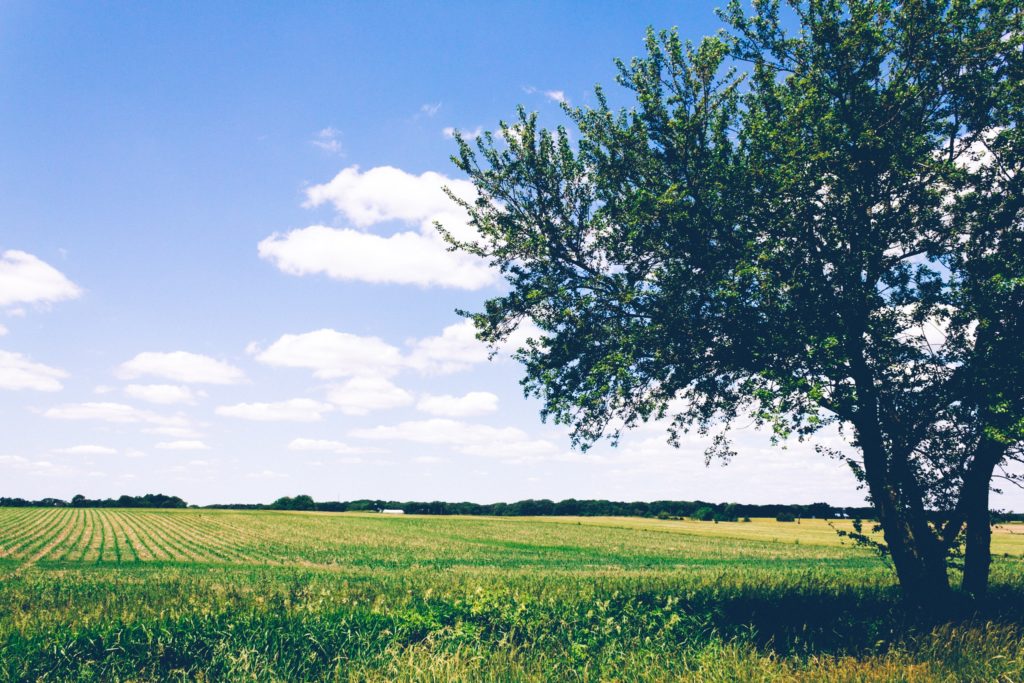
The word sustainability carries quite a bit of weight in the world of agriculture. More and more, farmers are making innovative choices to maintain sustainable, profitable farmland while helping to protect the environment from agricultural wear and tear.
Strategically placed, well designed soil buffers that protect the environment and preserve soil nutrients are essential to a farm’s long-term success. Here, we review some of the most common soil buffers in the agricultural industry.
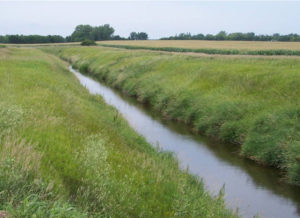 Riparian Buffer and Filter Strips
Riparian Buffer and Filter Strips A riparian buffer by definition can be complex, but the short story is that they are strips of vegetative land planted near water sources on a plot of farmland. These areas follow the flow of the water source, often establishing a natural property line.
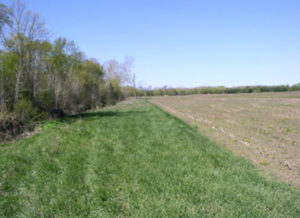
Filter strips are strategically placed grasslands, that provide filter between the farmland and the surface water source to reduce contamination of the water.
Photo courtesy Allegan Conservation District
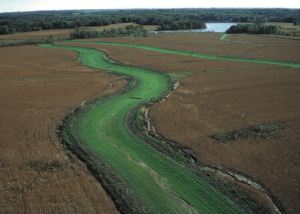 Grassed Waterways
Grassed WaterwaysIntentionally planted natural-ditch areas land, grassed waterways are wide, shallow channels that allow water to move through farmland. Grass in these depressions slows water flow and helps prevent against erosion.
Photo Courtesy National Farmers Union
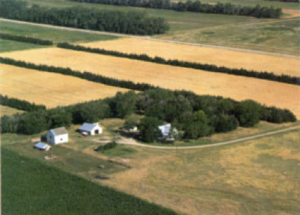 Shelterbelts, WindBreaks, and Living Snow Fences
Shelterbelts, WindBreaks, and Living Snow FencesShelterbelts, windbreaks, and living snow fences are all considered when wind, snow, and heat are a factor. They are typically comprised of one or more rows of trees and shrubs, and partially or completely surround a section of farmland. The belts protect livestock from harsh weather conditions, and help reduce erosion and evaporation. Often times, they serve as a natural property line. (Photo courtesy aftaweb.org)
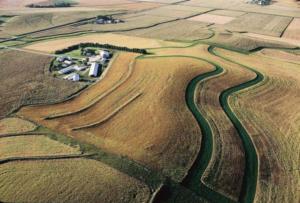 Contour Grass Strips
Contour Grass StripsContour grass strips are planted to run along or perpendicular to slopped farmland for the purposes of reducing erosion and runoff in hilly areas.
Photo by Lynn Betts, USDA Natural Resources Conservation Service. (1999)
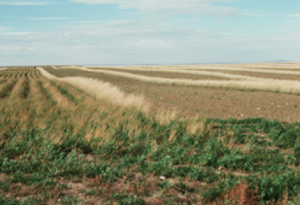 Cross-wind trap strips
Cross-wind trap strips The name says it all; these buffers trap blowing sediment and potential pollutants, and help prevent wind erosion. Comprised of herbaceous vegetation that can stand up to winds, cross-wind traps are planted perpendicular to the direction the wind most often pushes through.
Photo courtesy the Minnesota Department of Agriculture
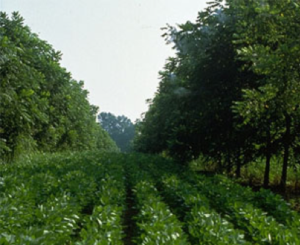 Alley cropping
Alley croppingWith alley cropping, buffers such as trees and shrubs are planted in spaced rows, with crop lying between.
Interestingly, alley cropping is often implemented not just for erosion and contamination prevention, but to better diversify farm products on a single piece of land, and to alter the microclimate for increased crop yield.
Photo courtesy aftaweb.org
A traditional use of soil buffers has been for the natural property line indicators. Need more than a natural fence to contain your farmland or livestock? Consider CBI Pipe & Supply your partner for the most dependable, highest quality fencing solutions.
Website SEO by Pakus Web Services by Pakus Trading Company, LLC.
NASPD – There is no question that the steel pipe markets have always been quite competitive. For producers of this piping, the fluctuating market continues to present new challenges. For distributors of steel pipe, the main challenge is to successfully retain older markets and move into new ones.
However, regardless of how volatile the market is, there are certain distributors and manufacturers who have made it through the tough times. Many of these companies are part of the National Association of Steel Pipe Distributors (NASPD).
The initial meeting of the NASPD occurred on April 17, 1975. It was hosted by Jerry Rubenstein and Peter Knowles. On this date, 51 steel pipe distributors sent 68 representatives to the meeting. The first Executive Director of the organization was Suzanne Letch, who remained in this post until 1979. During her time, she assisted in putting together the first annual conference that occurred the following year. More than 200 members and guests attended.
However, the NASPD is about much more than just social gatherings and conventions. By 1978 the organization had released the very first edition of “The Tubular Products Manual.” When 1989 arrived, they had an entire list of publications and materials that specifically addressed steel pipe distributors, which included:
Additional educational materials and publications followed, which included the NASPD Fundamental of Steel Pipe Products and the NASPD Training Manual. The organization even started offering educational classes, which included the OCTG Specialty Education Class, which took place in 2009. By 2011, NASPD was beginning to gain recognition from several prominent people in the industry by creating a Hall of Fame.
When you work with a company that is a member of the NASPD you are receiving peace of mind that you have found top professionals in this industry.
The NASPD represents the steel pipe and tubular products distribution industry. When you partner with a company that is a member of this national trade association, you can have confidence that you will receive all the following benefits:
Each member of NASPD works diligently to ensure customers are informed and educated during the entire selection and pipe buying process.
Feel free to contact us with any questions or inquiries!

Website SEO by Pakus Web Services by Pakus Trading Company, LLC.
Steel Production Types – Many North American clients prefer welded steel pipe because it is more affordable, readily available and offers a more consistent thickness. These appealing characteristics of steel are produced by the material used, along with the production methods. The is a main reason why steel is a popular building material around the farm, including modern barns made by top steel building manufacturers.
Welded steel pipes are created by taking flat substrates, such as HR coil or a steel plate and shaping then welding them. The pipe is then classified based on the approach used. One thing professionals consider is if the steel pipe is spiral welded or straight seam welded. Others device the material based on the purpose – i.e. manufacturing, agricultural, oil drilling, mining, etc.
One of the most common ways to classify a welded steel pipe is to look at the process used. This means classifying the steel pipes based on the production methods or the sub-processes. The results achieved will fall into one of the three following classifications.
This process is either low or high frequency. It is restricted to a size of (maximum) about 24” in diameter. This welded steel pipe results from the longitudinally welded HR coil.
The primary substrate used in this method is a heavy steel plate. Producers will choose one of the following two methods, which include:
The flat plate that results will have a straight seam stretched the entire length of the pipe. The standard sizes for this pipe option range between 12 and 18m. When this method is used, the quality of the weld is higher and features fewer defects. Steel production types.
This process, just as the name implies, results from a circular motion. The manufacturer will take the plate and wind and weld the substrate of the steel plate or HR coil in a spiral. This is a method that is referred to as helical submerged arc welded (HSAW). The product resulted is much thicker and longer than the other methods. In most cases, this is the preferred method because it is cost-effective, fast, efficient and simple.
Regardless of how a welded steel pipe is classified, the market for distributors and producers is extremely strong. A company that offers a diverse option of welded steel pipes is able to maintain consistent profits. If you are searching for a company to provide you with the welded steel pipe you need, search for one that strives to exceed the expectations of the API regarding quality.
Make sure to contact us with any questions or inquiries!
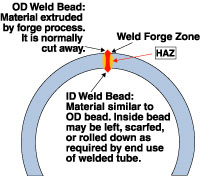
Website SEO by Pakus Web Services by Pakus Trading Company, LLC.